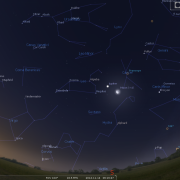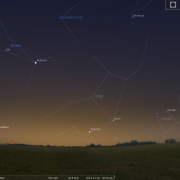In this month's Sky Notes:
- Planetary Skylights
- Meteor Activity
- Comet C/2013A1 Siding Spring passes Mars
- Rosetta Comet Chase: Update
- November 2014 Sky Charts
Planetary Skylights
 There is little notable planetary action in the evening sky during November. Mars continues in its race to outrun the Sun and the horizon, lingering just above the SW horizon for an hour after sunset. On the 25th & 26th it is joined by a crescent moon. toward the SW horizon.
There is little notable planetary action in the evening sky during November. Mars continues in its race to outrun the Sun and the horizon, lingering just above the SW horizon for an hour after sunset. On the 25th & 26th it is joined by a crescent moon. toward the SW horizon.
 By mid month conspicuous Jupiter is rising before midnight and is on view by 10pm at the month’s end across in the east. However as far as practical telescopic observations are concerned it really should still be classed as a morning object. By dawn it rides high to the SSW and is unmistakable, residing just ahead of Regulus and the ‘sickle’ in Leo. The Moon lies nearby on the 14th and 15th.
By mid month conspicuous Jupiter is rising before midnight and is on view by 10pm at the month’s end across in the east. However as far as practical telescopic observations are concerned it really should still be classed as a morning object. By dawn it rides high to the SSW and is unmistakable, residing just ahead of Regulus and the ‘sickle’ in Leo. The Moon lies nearby on the 14th and 15th.
 The planetary highlight of the month will be the continued morning apparition of the innermost planet; elusive Mercury. Look for it across in the ESE from the 1st until 20th around 45 mins before sunrise. Mercury will be highest at the start of November; a very respectable 10 degrees above the horizon and after a little searching should become readily apparent to the naked eye. As the month progresses Mercury will drop back toward the horizon getting brighter as it does so. Perhaps the optimum dates will be 12th to the 15th. Use binoculars if you cannot initially spot it.
The planetary highlight of the month will be the continued morning apparition of the innermost planet; elusive Mercury. Look for it across in the ESE from the 1st until 20th around 45 mins before sunrise. Mercury will be highest at the start of November; a very respectable 10 degrees above the horizon and after a little searching should become readily apparent to the naked eye. As the month progresses Mercury will drop back toward the horizon getting brighter as it does so. Perhaps the optimum dates will be 12th to the 15th. Use binoculars if you cannot initially spot it.

 Uranus came to opposition early last month and is now well placed for observation during the evening. See chart. Neptune is visible in a telescope and lies near Sigma Aquarii.
Uranus came to opposition early last month and is now well placed for observation during the evening. See chart. Neptune is visible in a telescope and lies near Sigma Aquarii.
Meteor Activity

Look out for the Leonids and Taurids during November:
 The Leonids are active from Nov 15-20 and will peak this year during the very late evening of Nov 17, which means the early morning of the 18th will be the optimum time to view. ZHR’s are expected to be normal, ie around 20 per hour, so an observer may expect to view around 7-12. The Leonids are usually a quiet shower but are famous for their outbursts. These meteor storms are expected roughly every 33 years (the orbital period of the showers parent comet - Temple Tuttle) The next one is not expected until 2030 at the earliest.
The Leonids are active from Nov 15-20 and will peak this year during the very late evening of Nov 17, which means the early morning of the 18th will be the optimum time to view. ZHR’s are expected to be normal, ie around 20 per hour, so an observer may expect to view around 7-12. The Leonids are usually a quiet shower but are famous for their outbursts. These meteor storms are expected roughly every 33 years (the orbital period of the showers parent comet - Temple Tuttle) The next one is not expected until 2030 at the earliest.  Keep an eye out for a few meteors on the night of Nov 4/5th when the South Taurid meteor shower reaches a peak, and then again on the night of Nov 11/12 when the North Taurid meteor shower peaks. This is a very long duration shower with a low rate of about 5 meteors per hour. The peak does not increase much from this, but both Taurid showers span over a month. Taurids may well be few, but they are very bright with bright fireballs and therefore well worth keeping an eye out for.
Keep an eye out for a few meteors on the night of Nov 4/5th when the South Taurid meteor shower reaches a peak, and then again on the night of Nov 11/12 when the North Taurid meteor shower peaks. This is a very long duration shower with a low rate of about 5 meteors per hour. The peak does not increase much from this, but both Taurid showers span over a month. Taurids may well be few, but they are very bright with bright fireballs and therefore well worth keeping an eye out for. The Taurids are an old shower, associated with Comet Enke, which has a period of just 3.3 yrs. Over time dust from this comet has been depleted and spread out over a broad swathe of the inner solar system, giving rise to Taurid meteor showers not only on Earth but also on Mars and Venus too!
The Taurids are an old shower, associated with Comet Enke, which has a period of just 3.3 yrs. Over time dust from this comet has been depleted and spread out over a broad swathe of the inner solar system, giving rise to Taurid meteor showers not only on Earth but also on Mars and Venus too!
Comet C/2013A1 Siding Spring Passes Mars
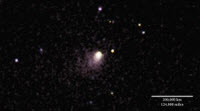
Comet C/2013 A1 Siding Spring
tears past Mars on its maiden
voyage into the inner solar system
Passing Mars at a distance of just 87 thousand miles, comet Siding Spring became the first comet from the Oort cloud to be studied up close, thanks to a battery of orbiters and landers in-situ at Mars. (Although most were parked out of harm’s way - just in case) The close passage of the comet on Oct 19th could even be followed live on the web. Mark will be giving a brief synopsis of events at the Nov meet. And so as one close encounter involving a comet becomes yesterday’s news, so another close encounter involving a comet will, if all goes to plan, become big news shortly.
The Rosetta Mission - Philae has landed!
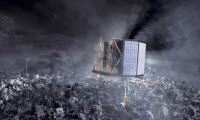
Artist's impression of "Philae",
Rosetta lander, on comet Comet
67P//Churyumov-Gerasimenko
Well, not yet, but we hope everything goes according to plan for possibly the highlight of the year for space related matters.
After its 10 yr journey, ESA’S Rosetta spacecraft finally rendez-vous-ed with comet 67P/ Churyumov - Gerasimenko on Aug 6th with the historic first landing of a probe on a comet scheduled to go ahead on Nov 12th. Touchdown will hopefully be around 4pm UK time, so keep tabs across the media.
Andi will be giving a presentation on the Rosetta mission at the Nov meeting. Update:- Please go to homepage - The day mankind landed on a comet.
November 2014 Sky Charts
Click each image to see a full-size Sky Chart:
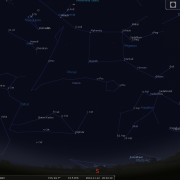 |
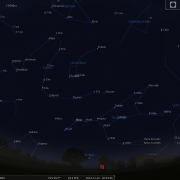 |
| Looking South Mid November - 21:00h |
Looking North |
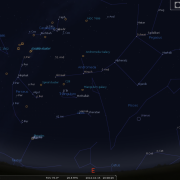 |
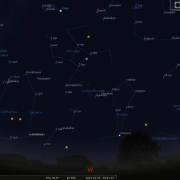 |
| Looking East Mid November - 21:00h |
Looking West Mid November - 19:45h |
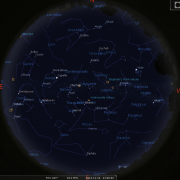 |
|
| Overview Mid-November - 21:00h |
Image Credits:
- Planets and Comets where not otherwise mentioned: NASA
- Artist's impression of "Philae": ESA / AOES Medialab
- Sky Charts: Stellarium Software
- Log in to post comments

